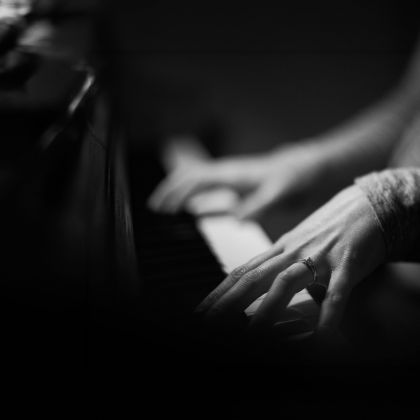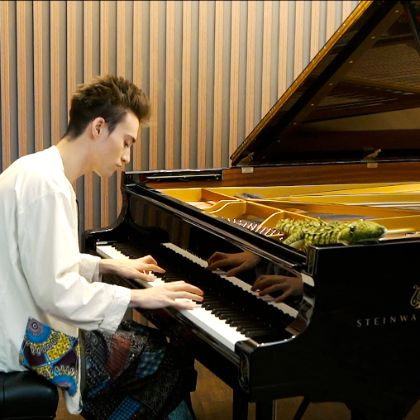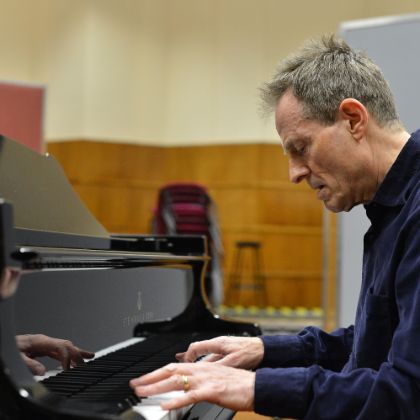Listen Magazine Feature
the time is ripe for a fuller appreciation of ferruccio busoni.
By Rebecca Schmid
the 150th anniversary of steinway immortal Ferruccio Busoni’s birth passed earlier this season without much fanfare. But the historical importance of the pianist and composer is only revealing itself more with the passage of time. While best known in his day as a virtuoso pianist and arranger of Bach and Liszt, Busoni stands alongside Schoenberg and Stravinsky as one of the twentieth century’s most formative figures.
Listeners are often to surprised to learn that Busoni taught Kurt Weill, who ended his career in musical theater, but also mentored Edgar Varèse, whose experimental compositions shaped the avant-garde on both sides of the Atlantic. Busoni’s principles transcended not just questions of style but politics and nationality. Everyone from Schoenberg and Hindemith to Louis Grünberg and Otto Lüning — seminal figures in the history of electronic music in the U.S.–owned marked-up copies of his Entwurf einer neuen Ästhetik der Tonkunst (Sketch for a New Aesthetic of Music).
“We did not lose a human being, but a value,” wrote Weill after Busoni’s death, calling him a “spiritual European of the future.” Busoni’s legacy is so far-reaching that it is hard to say where his greatest contribution lies: in his original works, scholarly editions, writings about music or teachings. His compositions may not have been taken seriously exactly because of his multiple talents.
But Busoni’s artistic ideals were also too non-dogmatic for a world that split increasingly along artistic and political lines. While he held up Mozart as a model of classical values and encouraged his students to move away from the heaviness of a German Romantic tradition embodied by Beethoven and Wagner, he did not reject those composers altogether. And while he had distaste for expressionist art, he was in close contact with Schoenberg and helped win him an invitation to Berlin.
‘We did not lose a human being, but a value.’
—Kurt Weill on the death of Busoni
As fate would have it, Busoni was then overshadowed by the avant-garde establishment following the First World War. The situation was only exacerbated by the fact that Busoni — Italian–born, and of Austrian and Corsican origin — did not champion purely German values in either his music or personal identity at a time of rising nationalism. In short, he was too German for the Italians and too Italian for the Germans.
In his last years, Busoni took refuge in a philosophical vision for the future of music and a small circle of disciples. “I am optimistic, but no longer for me,” he confided to a friend. His theory of Young Classicality — which is often confused with the Neo-classicism of Hindemith or Stravinsky — was in some ways a spiritual reaction to the war, a belief in the power of art to transcend time. Rather than breaking with the past, Busoni saw potential in building upon its foundations. “The absolute modern doesn’t exist,” he wrote in his Entwurf einer neuen Ästhetik der Tonkunst. “Only that which has arisen earlier or later, blooming longer or wilting more quickly.”
A prodigy at the keyboard, Busoni performed his own arrangements of Bach already as a ten-year-old, winning the attention of the influential music critic Edward Hanslick in Vienna. At the turn of the twentieth century, in his thirties, Busoni increasingly began to integrate his own harmonic and melodic innovations. The development reached its apex in the Fantasia contrappuntistica, where the forward-looking chromatic harmony of fragments from Bach’s Kunst der Fugue is pushed to the limit. For Busoni, arranging and composing were two sides of the same coin, a process in which the present entered into natural dialogue with the past.
It was of no concern to him that opera fantasies had long fallen out of fashion when he wrote his sixth and final sonatina, “Kammer-Fantasie über Carmen,” in 1920. By contrast, the Sonatina Seconda — completed in 1912 at the height of Busoni’s more experimental phase — entirely lacks a tonal center, assigning accidentals to each individual measure, and leaves out a time signature. While melodic patterns acknowledge the twelve-tone innovations of Schoenberg, the textures also absorb the impressionist innovations of Debussy.
The eclecticism of Busoni’s compositions was one reason for his lack of popularity with critics. His Piano Concerto — an approximately eighty-minute work culminating in a male choir — offended the Germans upon its 1904 premiere with its Italian “street songs,” while Italians were turned off by the Wagnerian nature of the third movement and use of the German language. The opening “Prologo e Introito” manages to combine the lightness of Mozart with the monumentality of Mahler, while the fourth “All’Italiana” is full of cheeky allusions to Mendelssohn’s “Italian” Symphony.
steinway artist Kirill Gerstein, who performed the concerto in March with the Boston Symphony for the first time in the orchestra’s history, calls the late Busoni “the James Joyce of music,” comparing the concerto to Finnegan’s Wake, which “you have to read with a compendium explaining all its virtuosic references.” At the same time, listeners who might not have an overview of western classical music history find Busoni’s music to be at turns “entertaining, pleasant and striking” in Gerstein’s experience. In April of next year, he performs the Romanza e Scherzoso — a highly Mozartean work written in 1921, three years before Busoni’s death — with the Gurzenich Orchestra Cologne and the Radio Symphony Orchestra Berlin.
The eclecticism of Busoni’s compositions was one reason for his lack of popularity with critics.
Busoni’s compositions are best understood in light of what Gerstein calls a tremendous “pianistic intelligence.” Had he lived into the age of modern recording, we might be able to experience more of his interpretive power. But we also know that he had a distaste for the industry. Upon recording Liszt’s Faust Waltz (the results of which were lost, perhaps to a fire), he complained that he had to tailor his playing and use of the pedal to “this devilish machine.”
A handful of acoustic Columbia recordings have survived, however, two of which — Liszt’s Hungarian Rhapsody No. 13 and Bach’s Prelude and Fugue in C Major from the Well-Tempered Clavier — are available on YouTube. Gerstein calls it one of the great “would-have-beens” of the recording industry that Columbia turned down the rights to record all 48 Preludes and Fugues, while marvelling at how Busoni “manages to melt the piano” in the one extant Liszt recording “so that it doesn’t sound like an object of wood and metal, but smoke and illusions.”
‘One doesn’t destroy, one builds up!’
—Ferruccio Busoni
Busoni was also an active promoter of music by his contemporaries, personally conducting works by composers such as Saint-Saëns, Debussy and Berlioz in a concert series that he launched with the Philharmonic in 1902. Elgar’s Dream of Gerontius was heard for the first time in Berlin, and Nielsen’s Second Symphony received its German premiere. But barely unable to cover costs, Busoni abandoned the endeavor after seven years. The programs had been a difficult sell not just to audiences but the players of the Philharmonic, whom he had to cajole to devote sufficient rehearsal time. Busoni’s own home remained a lively center, however, hosting important events such as a private performance of Schoenberg’s Pierrot Lunaire in 1913 where Schoenberg and Varèse made personal acquaintance. The song cycle in turn may have inspired Busoni’s “theatrical caprice” Arlecchino. Busoni’s omnivorous artistic sensibility extended to the possibilities of new technology, an interest which he nurtured in part through his correspondence with the Italian futurists. As early as 1888, he had thought about the possibilities of microtones. Aware of Thaddeus Cahill’s electronic telharmonium, patented stateside in 1897, Busoni in the 1920s drafted plans for a Dritteltonharmonium (a harmonium to produce thirds of tones). He did not live to see the instrument completed, and its location today has not been confirmed, but a detailed drawing of the keyboard was this season published by Bärenreiter in the exhibit book Busoni Freheit für die Tonkunst!
For Busoni, new instruments and new ways of dividing the scale would provide a means of bringing music into the future without losing sight of past developments. “One doesn’t destroy, one builds up!” he called out to composers. In what may seem a historical paradox, both Schoenberg and the arch-conservative Hans Pfitzner rejected the need for expanding the scale beyond its pre-existing twelve tones.
As the scholar Erin Knytt explores in her recent book Ferruccio Busoni and his Legacy, his interest in electronic instruments would in turn provide a spark for Varèse, Grünberg and Lüning. As important to their development, Knytt argues, was Busoni’s emphasis on an organic connection between form and content, where rhythm or sonority could become building blocks. His orchestral work Berceuse élégiaque — a copy of which he gave to Varèse with the dedication “All’illustro Futuro, l’amico Varèse, affezionamente, F. Busoni, 1910” (to the illustrious future, my friend Varèse, affectionately, F. Busoni) — unfolds at its own will, with rocking, impressionist textures in which harp, celeste and gong evoke the beyond.
While the connection may seem abstract, Knytt argues that “Varèse’s experimental music would have been unthinkable without Busoni.” Varèse’s Ionisation allows rhythmic texture to determine the form, limiting the palette to percussion. Sibelius, although he compared his own compositions favorably to those of Busoni, also admired the Berceuse and adopted a new approach to orchestration and form, abandoning his admiration for Wagner. According to Knytt’s research, Busoni and Sibelius two met over twenty times in Helsinki, Berlin, Leipzig, Weimar and London, building a relationship of mutual inspiration.
Perhaps only in the current age of stylistic pluralism can Busoni’s impact be appreciated in all its breadth.
Even more intriguing is the impact Busoni made on American musical life. Grünberg, who wrote symphonic music for the first time as a student of Busoni in Vienna, helped found the American Music Guild, International Society for Contemporary Music, and the League of Composers. His Emperor Jones was the eleventh opera to premiere at the Metropolitan Opera, in 1933. Much as Busoni presciently dreamed about microtones, Grünberg predicted the age of live streaming over half a century before it would become reality, envisioning “a city of millions, the streets eerily empty... but in every soundproof and closed room people are sitting, listening to their opera film or symphonic work in full enjoyment.”
Lüning, whose contact with Busoni was brief but intense, created the first works for electronic tape in the United States and presented his Fantasy in Space at the country’s first public concert of electronic music, in 1952. He was also active in promoting American opera, overseeing performances of Menotti’s The Medium and Thompson’s The Mother of Us All at Columbia University. Like Busoni, musical quality mattered more to him than style: His students — including John Kander, John Corigliano, and Charles Wuorinen — could not be more different.
As unfortunate as Busoni’s marginalization is the fact that names like Lüning and Grünberg are not better known among classical music aficionados. All three figures championed values that were ahead of their time and never lived to see them realized fully. Busoni, plagued by ill health and alcoholism, did not even survive to complete his final opera, Doktor Faust, which synthesized his entire compositional development into a personal statement: “Still exhausted all the symbols wait / That in his work are hidden and conceal’d / Their germs a later school shall procreate,” reads a verse of the libretto, which the composer himself wrote.
The score is a mystic journey where the rigor of German counterpoint meets with sensuous Italian lyricism, where allusions to Mozart’s Don Giovanni, Gounod’s Faust, Bach’s Ein fester Burg and Meyerbeer’s Les Huguenots reveal a mind that is not content to take on one of European history’s classic myths unless it can absorb all that has been written before. As Tamara Levitz has documented in her study Teaching New Classicality, Busoni’s students saw something truly Faustian in his pursuit of a such a lofty but also outmoded artistic vision.
Perhaps only in the current age of stylistic pluralism can Busoni’s impact be appreciated in all its breadth. If one considers that his ideas live on, at least indirectly, in the music of Grisey, Murail, Grant Still, Lindberg or Adès, Weill’s words in 1925 ring just as true today as they did then: “Musicians of all kinds stand under the spell of teachings which the dying Busoni proclaimed.”
This article originally appeared on listenmusicculture.com, Steinway & Sons’ award-winning magazine.
related...
-

Practice, Practice, Practice
Steinway Artists on the Rewards of Routine
by Laura Lee Smith
Read More -

Steinway Artist - Jacob Collier: Little Blue
Read More -

Steinway Artist - John Paul Jones
John Paul Jones (born John Baldwin on January 3, 1946) became a prolific music director and arranger of a range of prominent Sixties artists before forming Led Zeppelin with Jimmy Page in 1968. Since 1980, the multi-instrumentalist embarked on a solo career, and his collaborators have included the supergroup Them Crooked Vultures as well as Paul McCartney, Brian Eno, and Diamanda Galas.
Read More